The following article as published in ‘Vision Mound’ (The Adi Da Community magazine at the time), Vol 3, No.4, July/August 1980.

THIS MOMENT OF OUR EXPERIMENT
If you are really going to practice religion, you have to be capable of criticizing yourself and receiving criticism from others—and of making real changes on that basis. This is so for both individuals and communities who practice religion. And from time to time, in the midst of the enormously difficult adventure of creating an authentically religious community, you need to get very honest about what you have done and what you are doing. (Of course, you should stay and always be that honest. But, as anyone who has tried it can testify, there need to be times of real soul-searching to clear away the inevitable posturing, insensitivity, and reactivity that come into play when a whole gathering of people try to become what they are not yet totally fit to be.) As a group, and as individuals, you need to re-evaluate your past, reassess your present, and move forward with a sane and newly realistic picture of who you are, what you can and cannot do, and how you should live in this world.
The last few months have been such a time for the members and staff of The Free Communion Church. We have been moved to take a sober look at ourselves and our history and our immediate future. Some of our observations have been painful, some exhilarating. We’d like to share them with those of you who are familiar with our community and the teaching work of our teacher, Da Free John. And we’d like to inform you of our new intentions, based on all of our reflections to date.
THE PAST
What happens when an enlightened spiritual teacher or adept comes to town? It depends upon, among other things, the town itself. It depends on the time and place of his or her appearance, and on the character, interests, and spiritual readiness of those who respond to him or her. Jesus was born into the essentially religious (if somewhat hypocritically so) culture of the ancient Hebrews. Gautama was born into the essentially religious (if somewhat deludedly so) society of ancient India. When Sri Ramana Maharshi went as an enlightened boy of his late teens to live at the holy mountain Arunachala in South India, it was inevitable, despite his lack of any early interest in teaching others, that men of spiritual sensitivity would discover him and recognize his greatness and gather around him as devotees. When a mysterious young saint named Sai Baba appeared in the little Hindu village of Shirdi in the late nineteenth century, it was inevitable that, after a period of transition, he would come to be regarded something like a local god.
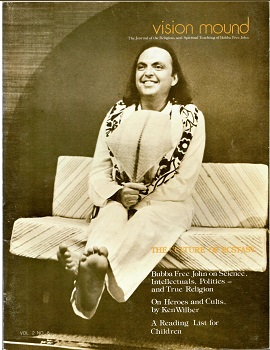
Da Free John, however, was born into the fundamentally secular society of mid-twentieth-century America. There was no one around who could notice his spiritual stature, no one to teach and instruct him from childhood about the mystical and yogic phenomena that were native to him from his earliest years. He was not born witha religious rule book in his hand. Nor, for that matter, were those who would become his early students. To gain the fullest understanding of human existence, Da Free John had no choice but to embark upon a totally experimental path of living and to depend upon Divine grace to guide him. Likewise, when he first started teaching jn 1972, he realized that those who were coming to him would never be able to benefit by merely verbal instruction. They also needed to enter into an experimental existence in order to learn rudimentary lessons about desire, experience, seeking, and relationships, about diet and sex, meditation and mystical experience, prayer and God, and what to do in the company of a man who is awake. Only when they had gained those lessons could they embark upon an authentically religious practice of life.
Almost all of us who approached this church in the early seventies had fallen out from the round of conventional society and the possibility of being served by mainstream religion. We didn’t have any answers—though certainly many of us thought we did! And we had nothing in common as a group, no ordinary reason for being together. But we were all intensely interested in Da Free John’s conversations with us, and in trying to live the way of life he recommended. It seemed to us—and it still does—that he was offering the most sane, happy, and sublime possibility we had ever encountered.
Now Da Free John is one of those uncommon teachers who could—and can—be of immense spiritual value not just to ordinary folks, but to great yogis, saints, and mystics. However, yogis, saints, and mystics were not among the people he welcomed into his storefront bookstore-church or “ashram” when he began teaching in 1972. At first, he wrote later, the kind of people who did come “caused me to despair.” But soon he realized that his own ordinary origins and the uninhibited freedom of his own adventure of transformation “equipped me very well to Serve such people” as a spiritual teacher.
Thus, for a number of years, Da Free John and his somewhat ragtag gathering of early students progressively dealt with one another to discover just what is the Truth and the best way to live.
At first he would sit and talk or meditate quietly with people in the bookstore on Melrose Avenue in Los Angeles a couple of nights each week. In the beginning he had no expectations. After a few months it became obvious that those who came should help support the place, and so financial support became a requirement for attendance. Later he suggested other “life-conditions,” such as managing one’s diet sanely and healthfully, exercising regularly, and the like.
It became evident, however, that his students were either unable or unwilling to manage their lives as a discipline. We could all play with the discipline a little bit, certainly, but we were still too emotionally unstable and distracted by our habitual cravings to easefully fulfill a natural, healthful, and moral practice. We were too uptight! And we had too many of our own programs that we still felt obliged, consciously or unconsciously, to play out before we could submit freely to religious rules.
After almost two years of observing the struggle in us between our street#level preferences for self-indulgence and our almost wistful attempts to be good disciplined people, Da Free John realized that he had become nothing more than the local yogi-pastor! He saw that people were not changing fundamentally as a result of merely hearing him talk about human responsibility and religious awakening. It is not that we were insincere—we were unequipped. We earnestly wanted to realize the sublime life that Da Free John taught and personally demonstrated. But we didn’t know how. We just could not effectively translate the teaching into our own daily lives and actions. We were spiritual cripples; we were like newborn infants trying to walk but not yet able even to stand.
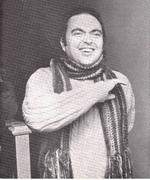
Therefore, after about two years of initial instruction, Da Free John simply submitted himself to us, to our desires, habits, inclinations, preferences in life, in order to make true change possible for us. He abandoned the natural distance that existed between us and him. To be sure, there had been personal contact during those first months and years. But he had remained for us essentially the teacher—the one who sat with us in meditation and talked there in the hall and in the back room of the bookstore, the one who brought the teaching and gave us the conditions for spiritual life. Now he began to live like and with the small gathering to whom he had previously spoken about the teaching. He became willing to live the way we by habit would like to live, to play out with us the inclinations and desires that were masked behind our “new age” dress, habits, and aspirations. He entered with us into a cycle of life that would enable us to see the errors of our habits and to grow into a new way of being.At times we partied together, sang, and amused one another uproariously. At other times we followed a straight or disciplined daily regimen and sat in formal meditation. Da Free John exuberantly joined us at times in living the self-indulgent way we all had always lived or wanted to live—and we willingly tried, in the other phase of our cycle of experiments, to adapt to the purifying, harmonizing, and clarifying practices that he recommended.
On the face of it, there was nothing extraordinary about this experimental approach to life. Many individuals and groups in the West had done and were doing very much the same thing- seeking by trial and error to discover the best way to live. Indeed, Da Free John pursued his own early explorations of life and consciousness in the midst of the social and cultural ferment of the late ’50s and, especially, the ’60s. What made our uninhibited experiment in the ’70s perhaps unique was, first, that it was occurring under the auspices of a church, a specifically religious institution, and second, that we pursued it with tremendous intensity and abandon and ultimately brought it—or at least its more apparently unconventional aspects—to an end.
We went on for two or more years, sometimes celebrating, sometimes sitting seriously in meditation, talking together, being hilarious and even ridiculous at times. But our purpose was not to live either a usual undisciplined life or, at times, an uncommonly disciplined one, for its own sake. Neither phase of our cycle, the way we tended to engage it, was what Da Free John had in mind as the right or enlightened approach to life. Thus, during the entire period he considered with us what we were doing, what we wanted to get out of it, what our motives and actual satisfactions, our frustrations and our aspirations, really were. He confronted us face to face, with great humor and compassionate sympathy, about all our obsessiveness and neurosis. It was a period of mutual submission, mutual self-examination, mutual enjoyment between an enlightened man and his ordinary friends. And it eventually did come to an end. After a couple of years, the cycle of extreme approaches to living was no longer necessary.
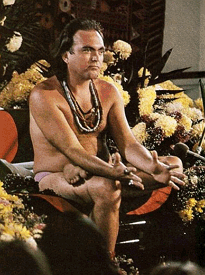
“To those who have suffered the insensitivity of our activities as an institution, or the excesses of our early experiments as a gathering, we offer our heartfelt apologies.”
We— the gathering in general, a group of several hundred people—came to the point of understanding how to live the wisdom that we had repeatedly heard from Da Free John and seen in his own life. At last we could understand the significance of personal and moral disciplines and the spirit with which they should be infused in every moment.
Take, for example, our consideration of and practice of sexuality. When we began our experiment, we were promiscuous and emotionally unstable people. But over the period of the celebrations in the mid seventies it became very clear to us—through direct experience and our teacher’s ceaseless questioning of us— that promiscuity is emotionally untenable as a way of managing our sexual relationships. Over time we have all realized a positive relationship to sexuality that has made our previous exaggerations obsolete. We found that our cravings for “free” sexual activity were based upon forms of bondage- self-possession, self-involvement, emotional weakness, a constant need for pleasurable release from the tensions of living unhappily and without responsibility to love.
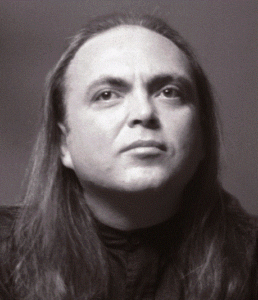
Now we have begun to realize sexuality as a form of communion with God, without gross guilt, self#possession, anger, remorse, and emotional contraction. We’ve grown into an emotionally sane and spiritually sophisticated understanding of sexuality and life. Our consideration of sex and marriage continues as an experiment, but now it takes place within stable marriages and patterns of courtship, and it is based upon already established emotional and human commitments. And we know—in the midst of a society whose social and intimate fabric of life has been ripped apart by all kinds of chaotic influences—that we have benign and healing wisdom to offer the world about sex and marriage, sex roles and sexual character. The same is true for diet, personal health care, exercise, childbirth and childrearing, education, religious awakening and prayer, work and service to others, and many other areas of life. We intend to bring this wisdom to others in ways that they can genuinely appreciate and effectively use.
Thus, the daily disciplines now practiced by members of this church evolved out of a voluntary experiment that stretched over several years. Our investigations had real results, in the form of agreements mutually reached about how we would live from then on. That is how our “rules” evolved.
During the last ten years, and particularly since the atrocity at Jonestown, many people have become fearfully suspicious even of the ordinary rules of daily life that are adopted in religious communities, as if such agreements amounted to violation of constitutional freedoms for those who abide by them. But religious institutions of an esoteric kind (in other words, those more serious about actual Divine awakening and real personal transformation than “downtown” churches) have always established life-disciplines as conditions for membership. The same is true for us. We have never been a nominal group of believers or weekend meditators. It has been said that this church is “hard to get into and easy to get out of.” Those of us who have been here have perhaps, through institutional incompetence, made it at times harder to get into the church than it should be. But it is still true that living this Way requires a real and ongoing commitment to change your life altogether.
“We are and have been a group of non-extraordinary people trying to practice an extraordinary way of life.”
We are and have been a group of non-extraordinary people trying to practice an extraordinary way of life. We are and have been a practicing church engaged in experiential consideration with one another and establishing agreements based on our insights and realizations. But we have also suffered the burden of trying to do this great thing. So have many others who have come close and gone away feeling confused or even burned. It has been an intense and sometimes wild experiment—and it has sometimes been managed institutionally by some of us who had either little experience or little sensitivity to others involved. The mechanics of supporting and managing this church have developed only with great difficulty. Likewise, even though we all have a basic grasp of the practice and the significance of the Way and the right relationship to the teacher and the church, the membership in general has still not altogether outgrown its original immaturity. We have not been and are not yet stable in loving communion with and surrender to God, nor yet stable in benign and peaceful service to others and the world.
“Despite some very real transformations that are uncommon in the world today, we remain, to date, not yet fully mature in our moral and spiritual commitments and action.”
Whenever we go through great changes in our life as a gathering (and there has never been a dull moment, as you may know) we tend to overestimate the extent of our conversion. We have even done so in writing many times, in this magazine and the books we have produced. Despite some very real transformations that are uncommon in the world today, we remain, to date, not yet fully mature in our moral and spiritual commitments and action.
To those who have suffered the insensitivity of our activities as an institution, or the excesses of our early experiments as a gathering, we offer our heartfelt apologies. We ask that you please continue to study this teaching and way of life. We do not feel that all we did was wrong. On the contrary, we feel we have passed through the early stages of this experiment and have come out the other side possessed of some extremely useful wisdom, and we are now better prepared to bring that wisdom to all who might benefit by it. But if you have in any way suffered the inevitable rough edges of our adventure, we do offer our apologies and urge you to bear with us and stay with us as friends.
THE TEACHER
Da Free John (Adi Da Samraj) has always longed to work with spirit#ually mature and humanly responsible people. He has repeatedly given his students opportunities to demonstrate maturity in love and effectiveness in making this Way of life available to the world. He has never had any desire to be the boon ‘companion of a bunch of childish, gleeful cultists. He has criticized that tendency in people around him—and it has certainly been there—from the very outset of his teaching work. He does not make himself available in any way that encourages such childish, fascinated impulses. He continuously practices self-criticism, as any spiritual man must do, even the supremely enlightened. Thus, where he has seen any kind of cultic or untrue expression resulting from his activities in this church, he has always and swiftly moved to correct the wrong influence and orient people rightly to God in Truth. He depends upon the church to deal with the immaturity of people’s approach to this way of life. To the extent that the church fails in this obligation, it tends to have less and less value from the enlightened point of view. And because the church is what it is—because we, the staff and membership, are what we are—there is much that our teacher does not value here! We are working to correct all that, and Da Free John is a patient and compassionate man who knows the value of even a faulty religious gathering over none at all.
At the height of the most dramatic times of our experimental life—in 1974 and 1975—Da Free John wrote the following explanation of his work and his own relationship to it:
***
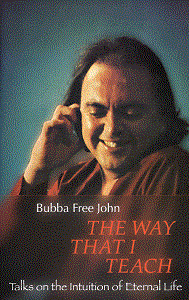
THE WAY I TEACH
What I do is not the way I am, but the way I teach.
What I speak is not a reflection of me, but of you.
People do well to be offended or even outraged by me. This is my purpose. But their reaction must turn upon themselves, for I have not shown them myself by all of this. All that I do and speak only reveals men to themselves.
I have become willing to teach in this uncommon way because I have known my friends, and they are what I can seem to be. By retaining all qualities in their company, I gradually wean them of all reactions, all sympathies, all alternatives, fixed assumptions, false teachings, dualities, searches, and dilemma. This is my way of working for a time. Those who remain confounded by me, critical of me, have yet to see themselves. When their mediocrity is broken, when they yield their righteous reactions and their strife toward all the consolations of the manifest self, they may see my purity.
Freedom is the only purity. There is no Dharma but Consciousness itself. Da Free John as he appears is not other than the possibilities of men.
***
This essay proved prophetic. The “way of working” that he described there did indeed only last “for a time.” It characterized the second great period of his early teaching work (1974- 1976)—the first, 1972-73, having been a time when he primarily spoke about the Teaching and Way and sat with others only on formal occasions . During the last several years, beginning in late 1976, Da Free John withdrew more and more from the daily activities of the institution and from informal personal contact with his students. He lived essentially in seclusion in this third period of his work, devoting his attention to the creation of his written teaching and releasing his devotees into the first and still immature phase of their responsibility for the church institution.
Then in September, 1979, he dropped the familiar and informal name “Bubba” (by which he had been known since late 1973) and he took the spiritual title “Da,” which means “teacher” or “one who gives.” (He himself describes the true significance of this name in the talk “Good Company,” which appears later in this issue.) He entered more formally and fully into seclusion as a member of the renunciate order of the church. (He has recently been joined in this order by a group of devotees who have also chosen to consecrate their lives to spiritual worship and service.) He also gave the church the responsibility to be the agent of this teaching, to carry on his spiritual work in the world.
Now Da Free John lives in privacy and seclusion. He does transcendental work in meditation for the sake of all beings. (Those familiar with the lives of spiritual adepts knowthat this is their principal activity, even though it is perhaps incomprehensible to our ordinary understanding and its effects may not be obvious to our eyes and ears.) Da Free John sees devotees only on rare occasions, as he chooses, for meditation and instruction. Basically, he has now shown the Way whereby devotess can live in direct communion with the eternal, infinite, and all-pervading God, of whom he, the teacher, is only a temporary and mortal agent.
It should be emphasized that, as a renunciate, Da Free John has neither public nor institutional obligations. The renunciate order transmits instruction for various levels of practice within the church, thereby performing the function within the church that the teacher once had. The institution in general now has the functions to communicate the teaching to the world and to create and provide services for members of the church and The Laughing Man Institute.
Da Free John’s seclusion is not a sign that he has nothing more to give to the world and to his devotees. Rather, it is a sign that the essential gifts have already been given. He has always worked to awaken men and women to the eternal and infinite God, the Spirit in every heart, and he has likewise always worked to prevent the formation around him of a traditional childish cult. He has created and identified three agents for the continued dissemination of spiritual help and instruction to the world: his written and practical Teaching, the community or church of his devotees, and the spiritual Sanctuaries or holy places that he has empowered. The church is pledged to provide, for all who are interested, full access to these agents of the Divine influence. We desire and intend to purify and strengthen in God our gathering and this institution, so that we, like our Divinely illumined teacher, may provide no obstacle to the healing and awakening Power of God.